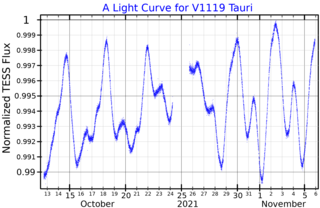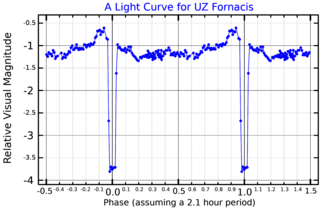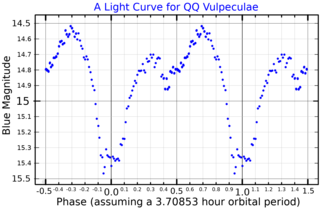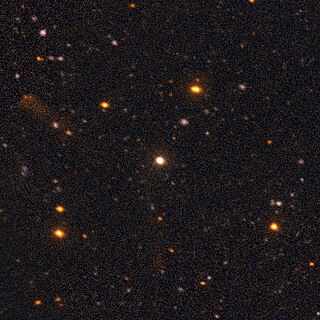Related Research Articles

A white dwarf is a stellar core remnant composed mostly of electron-degenerate matter. A white dwarf is very dense: its mass is comparable to the Sun's, while its volume is comparable to Earth's. A white dwarf's low luminosity comes from the emission of residual thermal energy; no fusion takes place in a white dwarf. The nearest known white dwarf is Sirius B, at 8.6 light years, the smaller component of the Sirius binary star. There are currently thought to be eight white dwarfs among the hundred star systems nearest the Sun. The unusual faintness of white dwarfs was first recognized in 1910. The name white dwarf was coined by Willem Jacob Luyten in 1922.
HR 3643 is a binary star system in the southern constellation of Carina. It has the Bayer designation G Carinae, with HR 3643 being the star's designation in the Bright Star Catalogue. The system is visible to the naked eye with an apparent visual magnitude of 4.48. It is located at a distance of approximately 401 light years from the Sun based on parallax, and is drifting further away with a radial velocity of +22.5 km/s.
HD 107148 is a wide binary star system in the constellation of Virgo. A pair of exoplanets have been confirmed in orbit around the brighter star. This system is located at a distance of 161 light years from the Sun based on parallax measurements, and is drifting further away with a radial velocity of 25.2 K. Although having an absolute magnitude of 4.47, at that range the system is too faint to be visible with the naked eye, having an apparent visual magnitude of 8.01.

GD 362 is a white dwarf approximately 150 light years from Earth. In 2004, spectroscopic observations showed that it had a relatively high concentration of metals in its atmosphere. Since the high gravitational field of white dwarfs quickly forces heavy elements to settle towards the bottom of the atmosphere, this meant that the atmosphere was being polluted by an external source. In 2005, infrared photometric observations suggested that it was surrounded by a ring of dust with size comparable to the rings of Saturn, providing an explanation for this pollution.

111 Tauri is a wide binary star system in the constellation Taurus. It is located at a distance of 48 light years from the Sun. Primary component A is a main sequence star with a stellar classification of F8V. The secondary component B is a K-type main sequence star. The primary is larger and more luminous than the Sun, with about 130% of the Sun's radius and 185% of the Sun's luminosity. The apparent magnitude of 5.0 indicates it is a faint star that can be viewed by the naked eye under good, dark-sky conditions.

QS Telescopii is a faint, well-studied binary star system in the southern constellation Telescopium. It is composed of a white dwarf and main sequence donor star, locked into a close, circular orbit facing one another. Known as polars, material from the donor star does not form an accretion disk around the white dwarf, but rather streams directly onto it. This is due to the presence of the white dwarf's strong magnetic field. The pair undergo frequent shifts between a high and low accretion states, and it shifts between single and double accretion poles. The main pole is partially self-eclipsing.
WD 1145+017 is a white dwarf approximately 476 light-years from Earth in the constellation of Virgo. It is the first white dwarf to be observed with a transiting minor planet orbiting it.
SW Sextantis variable stars are a kind of cataclysmic variable star; they are double-star systems in which there is mass transfer from a red dwarf to a white dwarf forming a stable accretion disc around the latter. Unlike other non-magnetic cataclysmic variables, the emission lines from hydrogen and helium are not doubled, except briefly near phase 0.5.

WD 0145+234 is a white dwarf star approximately 95 ly (29 pc) from Earth in the constellation of Aries that has been associated with studies suggesting that a very large exoasteroid near the star was substantially disrupted, resulting in a considerable amount of dust and debris around the star. Alternatively, the outburst around WD 0145+234 is explained with ongoing collisions between planetesimals inside the dusty debris disk around the white dwarf.

UZ Fornacis is a binary star in the constellation of Fornax. It appears exceedingly faint with a maximum apparent magnitude 17.0. Its distance, as measured by Gaia using the parallax method, is about 780 light-years.

SDSS J1228+1040 is a white dwarf with a debris disk around it. The disk formed when a planetary body was tidally disrupted around the white dwarf. It is the first gaseous disk discovered around a white dwarf.

WD 1054–226, also known as LP 849-31, is a relatively cool magnitude 16 white dwarf star with a hydrogen atmosphere, in the small southern constellation of Crater located approximately 117 light years away at right ascension 10h57' and declination −22°53'. The name WD 1054–226 is based on the coordinates in the J1950 epoch. The star was recognized as a white dwarf along with 32 other nearby white dwarfs in 2007.

V1005 Orionis is a young flare star in the equatorial constellation of Orion. It has the identifier GJ 182 in the Gliese–Jahreiß catalogue; V1005 Ori is its variable star designation. This star is too faint to be visible to the naked eye, having a mean apparent visual magnitude of 10.1. It is located at a distance of 79.6 light years from the Sun and is drifting further away with a radial velocity of 19.2 km/s. The star is a possible member of the IC 2391 supercluster.

QQ Vulpeculae is a cataclysmic variable binary star system in the northern constellation of Vulpecula, abbreviated QQ Vul. It has a brightness that fluctuates around an apparent visual magnitude of 14.7, which is too faint to be viewed with the naked eye. The distance to this system is approximately 981 light years based on parallax measurements.

SDSS 1557 is a binary system composed of a white dwarf and a brown dwarf. The system is surrounded by a circumbinary debris disk. The debris disk was formed when a minor planet was tidally disrupted around the white dwarf in the past.

WD 0816–310 is a magnetic white dwarf with metal pollution, originating from the tidal disruption of a planetary body. The metals are guided by the magnetic field onto the surface of the white dwarf, creating a "scar" on the surface of the white dwarf. This scar is rich in the accreted planetary material.

GALEX J2339–0424 is a white dwarf that is suspected to be polluted with material originating from an icy exomoon. This is evident from the first detection of beryllium in this white dwarf, together with GD 378.
References
- 1 2 3 4 5 6 7 8 9 10 11 12 "SIMBAD Query Result: GD 356". SIMBAD. Centre de Données astronomiques de Strasbourg . Retrieved 13 June 2012.
- 1 2 3 4 5 Walters, N.; Farihi, J.; Marsh, T. R.; Bagnulo, S.; Landstreet, J. D.; Hermes, J. J.; Achilleos, N.; Wallach, A.; Hart, M.; Manser, C. J. (2021-05-01). "A test of the planet-star unipolar inductor for magnetic white dwarfs". Monthly Notices of the Royal Astronomical Society. 503 (3): 3743–3758. arXiv: 2103.01993 . Bibcode:2021MNRAS.503.3743W. doi: 10.1093/mnras/stab617 . ISSN 0035-8711.
- 1 2 3 Brown, A. G. A.; et al. (Gaia collaboration) (2021). "Gaia Early Data Release 3: Summary of the contents and survey properties". Astronomy & Astrophysics . 649: A1. arXiv: 2012.01533 . Bibcode:2021A&A...649A...1G. doi: 10.1051/0004-6361/202039657 . S2CID 227254300. (Erratum: doi:10.1051/0004-6361/202039657e). Gaia EDR3 record for this source at VizieR.
- 1 2 Muir, Hazel (1 August 1998). "The Earth could be in for an electrifying time". New Scientist (2145): 7.
- 1 2 3 4 5 6 7 8 9 10 Wickramasinghe, Dayal T.; Farihi, Jay; Tout, Christopher A.; Ferrario, Lilia; Stancliffe, Richard J. (9 February 2010). "Does GD356 have a Terrestrial Planetary Companion?". Monthly Notices of the Royal Astronomical Society . 404 (4): 1984–1991. arXiv: 1002.1761 . Bibcode:2010MNRAS.404.1984W. doi: 10.1111/j.1365-2966.2010.16417.x . S2CID 119255099.
- 1 2 3 Ferrario, Lilia; Wickramasinghe, Dayal T.; Liebert, James; Schmidt, Gary D.; Bieging, John H. (1997). "The Magnetic Field and Emission-Line Spectrum of the Remarkable White Dwarf GD 356". Monthly Notices of the Royal Astronomical Society. 289 (1): 105–116. Bibcode:1997MNRAS.289..105F. doi: 10.1093/mnras/289.1.105 .
- ↑ Brinkworth, C. S.; M. R. Burleigh; G. A. Wynn; T. R. Marsh (2004). "Photometric variability of the unique magnetic white dwarf GD 356". Monthly Notices of the Royal Astronomical Society. 384 (3): L33–L37. arXiv: astro-ph/0312311 . Bibcode:2004MNRAS.348L..33B. doi: 10.1111/j.1365-2966.2004.07538.x . S2CID 15677179.
- 1 2 3 4 5 Greenstein, Jesse L.; James K. McCarthy (15 February 1985). "Emission lines in the magnetic white dwarf GD 356". Astrophysical Journal, Part 1. 289: 732–747. Bibcode:1985ApJ...289..732G. doi:10.1086/162937. ISSN 0004-637X.
- ↑ Reding, Joshua S.; Hermes, J. J.; Clemens, J. C.; Hegedus, R. J.; Kaiser, B. C. (2023-06-01). "Two new white dwarfs with variable magnetic Balmer emission lines". Monthly Notices of the Royal Astronomical Society. 522 (1): 693–699. arXiv: 2302.10207 . Bibcode:2023MNRAS.522..693R. doi: 10.1093/mnras/stad760 . ISSN 0035-8711.
- 1 2 Manser, Christopher J.; Gänsicke, Boris T.; Inight, Keith; Robert, Akshay; Ahlen, S.; Allende Prieto, C.; Brooks, D.; Cooper, A. P.; de la Macorra, A.; Font-Ribera, A.; Honscheid, K.; Kisner, T.; Landriau, M.; Meisner, Aaron M.; Miquel, R. (2023-06-01). "DAHe white dwarfs from the DESI Survey". Monthly Notices of the Royal Astronomical Society. 521 (4): 4976–4994. arXiv: 2302.01335 . Bibcode:2023MNRAS.521.4976M. doi: 10.1093/mnras/stad727 . ISSN 0035-8711.
- ↑ Lanza, A. F.; Rui, N. Z.; Farihi, J.; Landstreet, J. D.; Bagnulo, S. (2024-09-01). "Atmospheric heating and magnetism driven by 22Ne distillation in isolated white dwarfs". Astronomy and Astrophysics. 689: A233. arXiv: 2407.19289 . Bibcode:2024A&A...689A.233L. doi:10.1051/0004-6361/202449947. ISSN 0004-6361.
- ↑ Elms, Abbigail K.; Tremblay, Pier-Emmanuel; Gänsicke, Boris T.; Swan, Andrew; Melis, Carl; Bédard, Antoine; Manser, Christopher J.; Munday, James; Hermes, J. J.; Dennihy, Erik; Nitta, Atsuko; Zuckerman, Ben (2023-10-01). "An emerging and enigmatic spectral class of isolated DAe white dwarfs". Monthly Notices of the Royal Astronomical Society. 524 (4): 4996–5015. arXiv: 2307.09186 . Bibcode:2023MNRAS.524.4996E. doi: 10.1093/mnras/stad2171 . ISSN 0035-8711.